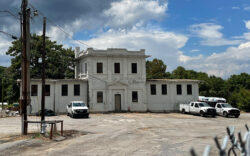After white supremacist Dylann Roof slaughtered nine black churchgoers in June, Confederate flags started descending from their proud perches across the South. The Alabama governor quietly ordered the old symbol of the Confederacy down at the Montgomery statehouse. South Carolina finally removed its infamous flag from the Capitol grounds.
But what would happen to Athens’ most prominent Confederate flag, the one flying at the bar General Beauregard’s in the heart of downtown? Would new students, their families and campus visitors be welcomed to Athens in the fall with our massive Confederate monument on Broad Street, a bar named after Confederate general Stonewall Jackson and, most egregious, a bar flying the Confederate symbol out onto Clayton Street and named after the general who started the Civil War?
I went to General Beauregard’s to talk to bar staff and patrons about the maligned symbol flying out front. General’s, in the dense center of the Athens student bar scene on Clayton Street, has for more than a decade announced to downtown denizens its rejection of modernity by flying the old Georgia flag, decommissioned in 2000 after a nasty political fight due to its essentially being a Confederate battle flag.
It was gone. And not only was the outside flag gone, but so, too, were the flags that used to adorn the inside. Behind the bar used to hang the Confederate battle flag and the first official flag of the Confederate government; another flag or two could be found on the back wall. All gone. It used to be that you couldn’t swing a dead Confederate inside the place and not hit a symbol of the slave state, and now it’s like a Where’s Rebel Waldo.
Behind the bar, Mack Peeples and Megan Banks explained that the owner had decided to take it down shortly after the shooting in Charleston. They spoke about threats that the bar had been receiving, one of which sounded quite serious. And while that surely had something to do with taking it down, it seems like the decision was based on a broader consideration. If the flag came down in South Carolina, where the bar’s namesake ordered the first shots on the U.S. Army to ignite the Civil War, if that most proudly Southern of states found it best to remove the symbol, why would General’s choose to have that fight? It’s a business, after all—sell drinks, make money, and eliminate obstacles to make sure that continues unabated.
Peeples and a few regulars at the bar were unhappy about the decision. Taking the flag down “was detrimental to our brand,” said Peeples. “I feel like the flag symbolizes our bar. It wasn’t a symbol of anything else.” He reported that some patrons had complained about the flag being taken down, a sentiment echoed by the handful of guys at the bar.
Though she likes the flag, Banks saw things differently. “It’s not going to deter anyone from coming here,” she said. “Everyone still knows this is a country bar. Just because we don’t have the flag doesn’t mean we’re not a country bar.”
Banks spoke, too, of the bar’s “brand.” I’d walked in expecting to find perhaps intense resentment and pitched emotions, not marketing-speak and careful thinking about the bar’s “brand.” Banks took a rational approach and separated her own feelings about the symbol from matters of business: “My personal preferences aside, I don’t think it’s a big deal [to take the flag down], and I’m gonna go along with what helps profit.”
She had clearly been considering the matter and was reconciled with it, “if it’s what needs to happen as people evolve.” She continued, “If the Confederate flag offends certain people—it doesn’t offend me—but if it offends certain people, then I need to evolve in my thought. The whole world needs to evolve in their thought, and that’s how you move along in society.”
There is a Confederate flag symbol inside General Beauregard’s if you look hard enough, but it’s inside, tucked away a little in a display case with bar memorabilia. The bar doesn’t scream into the street with its flag as before.
Open celebration of the old Confederacy is rare these days. The old flags are coming down. No one lays flowers at the Confederate monument on Confederate Memorial Day anymore. But the massive stone structure, a tribute to the rebellion, in the very heart of downtown, just feet away from the Arch, remains standing—more than 30 feet tall, as big and as grand as Athens could afford after the war.
The monument made sense at the time of its erection, at least for the half of Athens that was white. Their Confederacy had been put down, harshly so in East Georgia by General Sherman, and federal troops occupied what Southerners felt to be their country. To white Athenians of the time, commemorating the dead soldiers was a way to maintain resistance against the North. Citizens of Athens began almost immediately during Reconstruction to raise funds for the gothic obelisk. They were defeated for now, but the monument stood as a symbol of how the South would reverse the changes forced upon them by the federal government. Blacks would be put back in their place.
A speaker at the monument’s unveiling in 1872 “predicted that the South would rise out of its present low estate forced upon it by the atrocious Reconstruction policies of the Radicals,” according to an account by historian E. Merton Coulter. The speaker continued: “In spite of years of what is called ‘peace’… in spite of the humiliation the deepest and most shameful; in spite of oppression the most tyrannical and malignant; in spite of robbery the most flagrant and atrocious; in spite of all the vials of wrath that the most cruel and develish [sic] hate could pour upon their heads… they [the dead soldiers] have exhibited a recuperative energy and power unparalleled in history.”
The rebellion lived in the monument. It announced in the permanence of stone the temporary nature of the Confederacy’s loss. Anyone visiting Athens knew that the city had not given up.
The monument was the second such symbol erected in Georgia, helping to spark a quickly spreading movement to build similar structures throughout the South. And like nearly all of them, Athens’ spire still stands, still promising that the South will “rise again.” Its original cry might be only a faint, hoarse echo now, but it was not built to speak anything else. We just have to hope no one’s listening.
Like what you just read? Support Flagpole by making a donation today. Every dollar you give helps fund our ongoing mission to provide Athens with quality, independent journalism.










